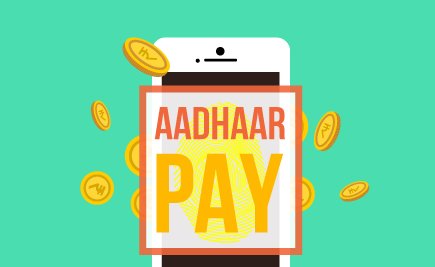
With the government taking initiatives toward transforming the economy into a less cash-dependent one, multiple payment options have surfaced in the financial ecosystem in the last few months.
From retailers to banks, every enterprise has taken to digital transactions through Credit and Debit Cards, e-wallets, UPI, mobile banking, etc. With the 2017 budget, the government has taken digital transacting one notch higher by proposing the addition of 20 lakh Aadhaar-based POS systems by September, 2017. An Aadhaar card has a unique identification number which works as a proof of identity and can be used as a mode of payment once linked to the bank account.
Additional Reading: Tax-filing made easy with Aadhaar
How Aadhaar Pay works
As a customer, you require three things to carry out a transaction: your Aadhaar card number, your bank account linked to your Aadhaar card, and your fingerprint to authenticate the transaction.
A merchant on the other hand would need to install a fingerprint/biometric scanner, a smartphone with the number linked to the bank account, Aadhaar Pay App on the phone, an internet connection and a bank account to receive payments.
The merchant must first install the Aadhaar Pay App on his smartphone and create his ID by registering on it. Thereafter, the smartphone should be linked with the fingerprint scanner. Once the setup is completed, the customer can provide the name of his/her bank, Aadhaar number and register his/her fingerprint on a biometric scanner to authenticate the transaction.
Advantages of Aadhaar Pay
This is highly effective for people living in rural and semi-urban areas when it comes to drawing them into the formal financial and banking system. The regions which were cash driven due to lack of access to plastic money and e-wallets can now enjoy hassle-free transactions through Aadhaar cards.
Transactions through Aadhaar do not attract any extra charges unlike Debit or Credit Cards at POS machines where you need to pay additional charges. While a POS machine costs more than Rs. 5,000, a biometric scanner for Aadhaar Pay can be installed for Rs. 2,000 only.
Transactions through Aadhaar Pay are more secure than any other digital mode of payment as it involves registering of biometric details which get encrypted and therefore cannot be stolen easily.
Another thing to note is that there are no annual charges associated with Aadhaar-based payments.
Additional Reading: Aadhaar-Enabled System For Merchant Payment
| Aadhaar Pay vs POS/Card VS Wallet | |||
| Aadhaar Pay | POS/Card transaction | Wallet | |
| Customer requirement | Aadhaar card number registered with the bank account and fingerprint for biometric validation | Debit/Credit Card | Smartphone |
| Merchant requirement | Biometric Scanner- cost Rs. 2000 (approximately) | POS Machine- Cost Rs. 5000 (approximately) | Smartphone with application |
| Charges | NIL | Up to 1% | NIL |
| Limitation | Needs internet connectivity | High transaction cost | Needs internet connectivity |
Limitations
Aadhaar pay works only where there is internet connectivity. While it is an effective mode of payment at merchant points, it cannot be used to transfer funds to another account.
If a customer wants his money back after making a payment, there’s no way to find out immediately if the money has been credited back to his/her bank account.
Additional Reading: Paperless Transactions Through Aadhar Card
E-wallets Vs Aadhaar Pay
E-wallets require you to carry a smartphone, thus limiting its access to a certain set of people. You need to transfer money from your bank account to load your e-wallet before use which may not seem user-friendly to many. Aadhaar Pay, on the other hand, is directly connected to your bank account allowing you to make payments without any limitations.
However, e-wallets offer cashback and discounts on merchandise through business tie-ups, which are missing in the case of Aadhaar Pay.
Aadhaar Pay is going to revolutionise with time and with eKYC connecting all banks to a single Aadhaar number, it will boost financial inclusion significantly.
